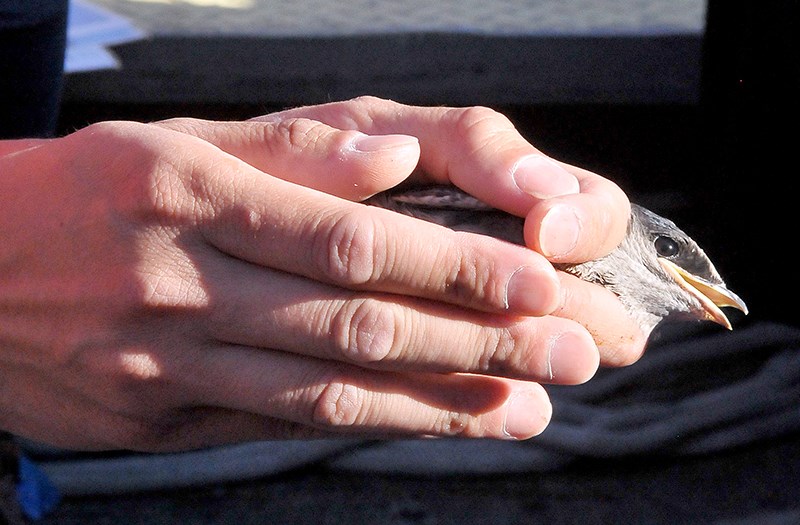See photo gallery above
The banding of the nestling purple martins — perched above the waters of Port Moody Inlet — has become a ritual for its dedicated attendants.
Every July, the volunteers from the Burke Mountain Naturalists and the Burrard Inlet Marine Enhancement Society (BIMES) hop aboard Rod MacVicar's herring skiff and travel the short distance from the Rocky Point pier.
On the day The Tri-City News was invited out to document the annual project, it was particularly windy, said Roy Teo of BC PUMA Stewardship and Recovery, who has been watching the migration of the neotropical western species in the Lower Mainland for about a decade.
Still, the evening sky was blue and the tide was high — high enough so that Naturalists' Kiyoshi Takahashi, John Saremba and Elaine Golds could steer the bow of MacVicar's Medusa 2 up to the pylons and pull the juvenile martins from their nests.
For the two dozen or so boxes that were emptied, it was the same process: a bird in a cloth bag was handed over to Teo, who then showed his team how to band and measure it.
Using what's called a bander's grip, Azim Shariff, Else Mikkelsen and Christina Saremba trapped the bird's head and shoulders between their fingers so the martins couldn't fly away. Then, a small metal band was fixed onto their legs to help researchers track the birds' survival rate.
About two minutes later, the bird was gently placed back into its box, ready to eventually make its 11,000-km journey to the Amazon rainforest.
The Rocky Point nesting boxes were mounted in 1994, thanks to a program by B.C.'s environment ministry. BIMES' Ruth Foster — like MacVicar, a retired teacher — said some of her fish and wildlife students at Centennial secondary school helped build and install them.
They are designed to attract the western purple martins — an oversize swallow — back to B.C.'s south coast. About 20 years ago, the species was nearly wiped out in large part to the starling taking over its nesting site, MacVicar said.
Measures were taken to save them from extirpation (local extinction) and, now, Takahashi has also placed martin boxes at freshwater sites at Stave Lake and Colony Farm to add to the population.
Foster said this year's count at Rocky Point Park was especially encouraging, with 84 birds handled. "This was the best year with the highest number of pairs we ever had," Takahashi told The Tri-City News later.
The Western Purple Martin Foundation, which operates a recovery program on Vancouver Island, is attributing its high numbers this year to the warmer weather and plentiful amount of bugs — dragonflies, moths and beetles — that are feeding the juveniles' bellies before their big trip south next month.
[email protected]
@jwarrenTC



